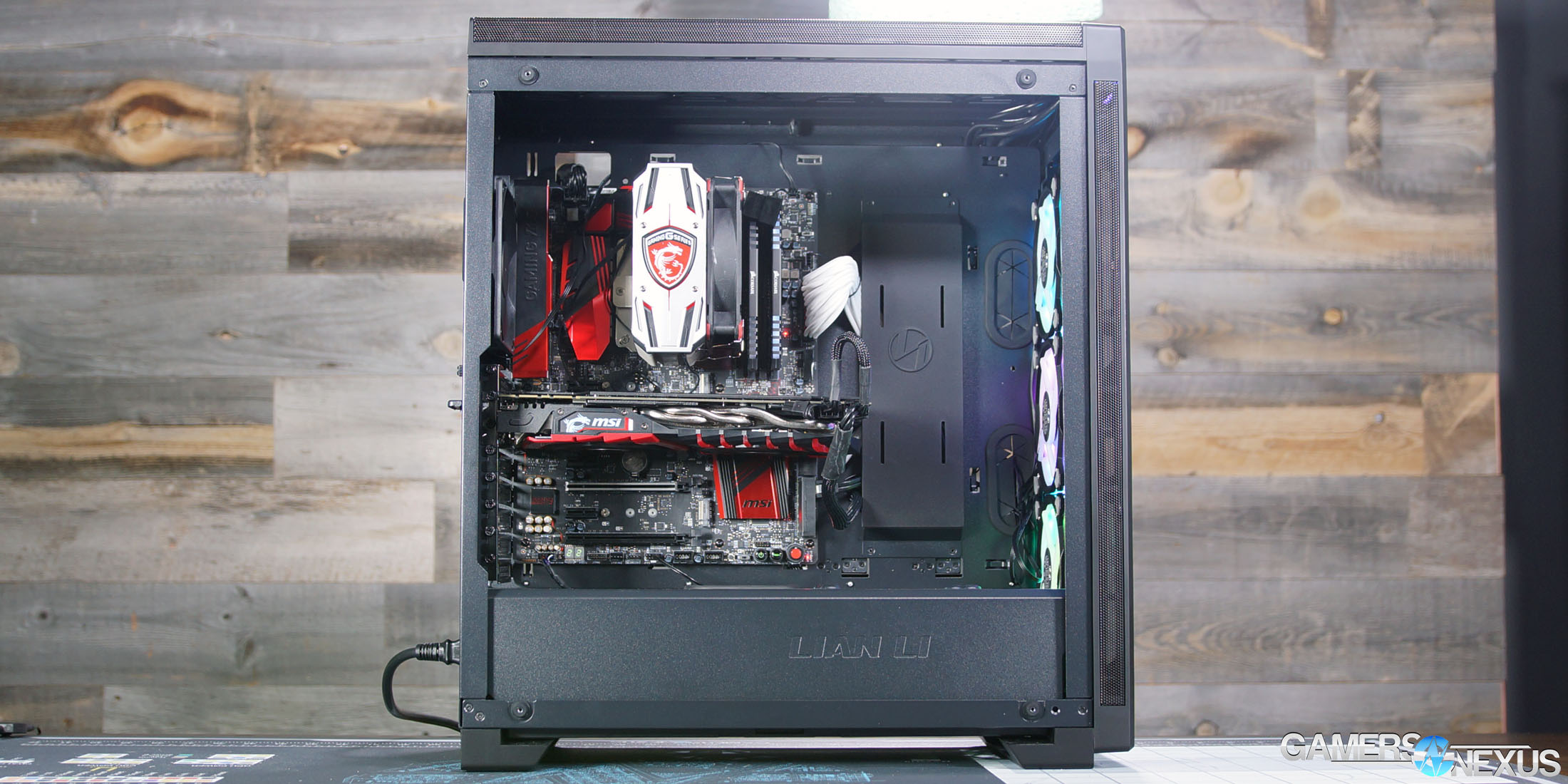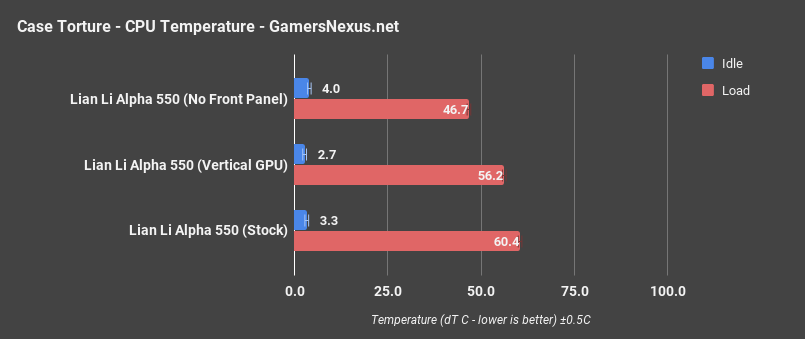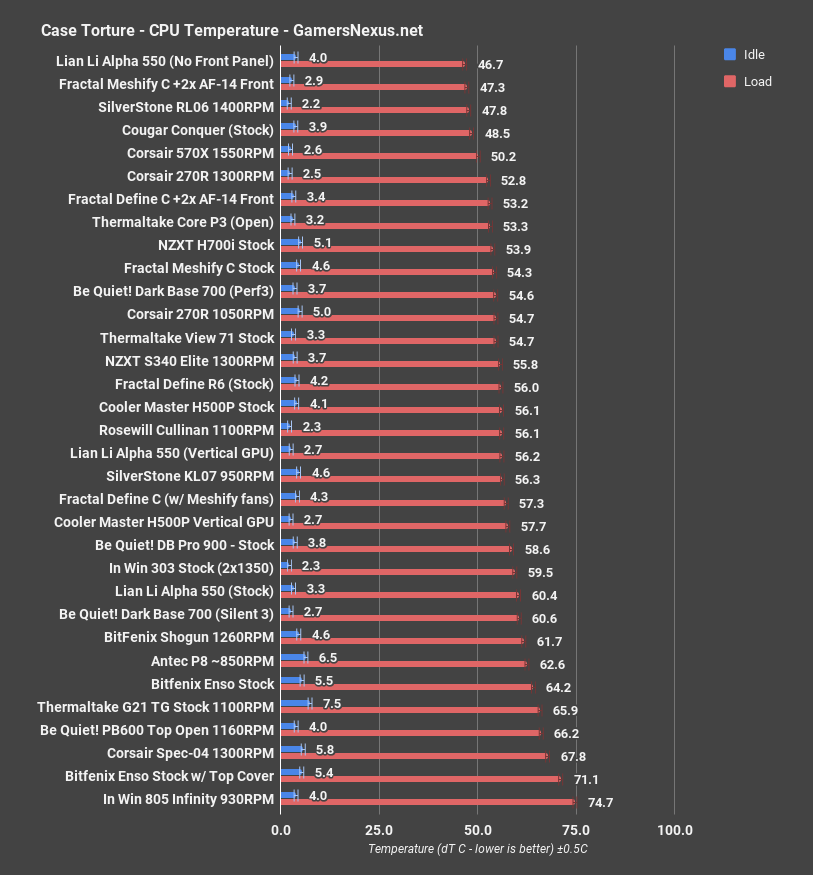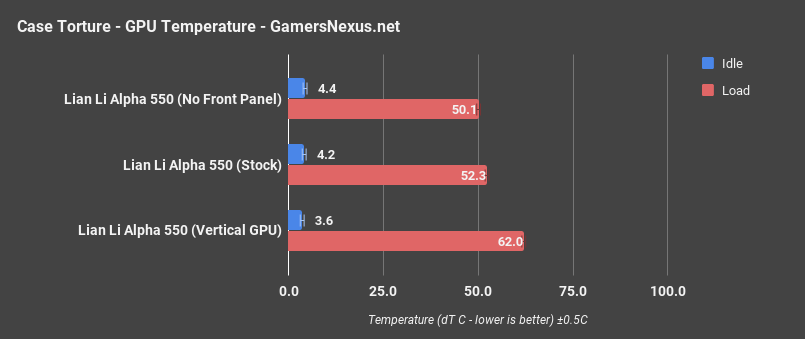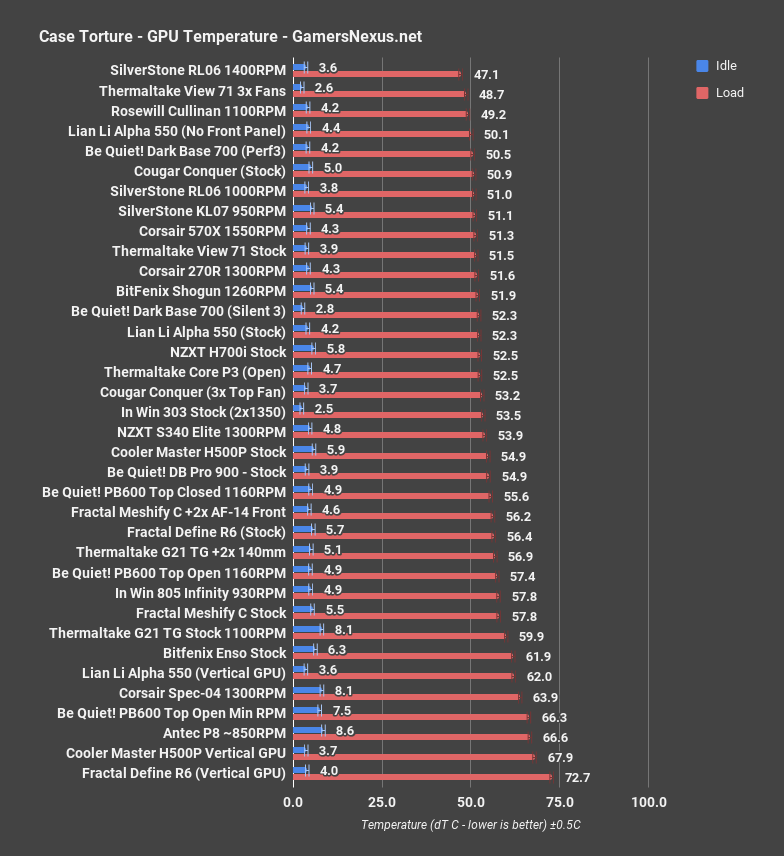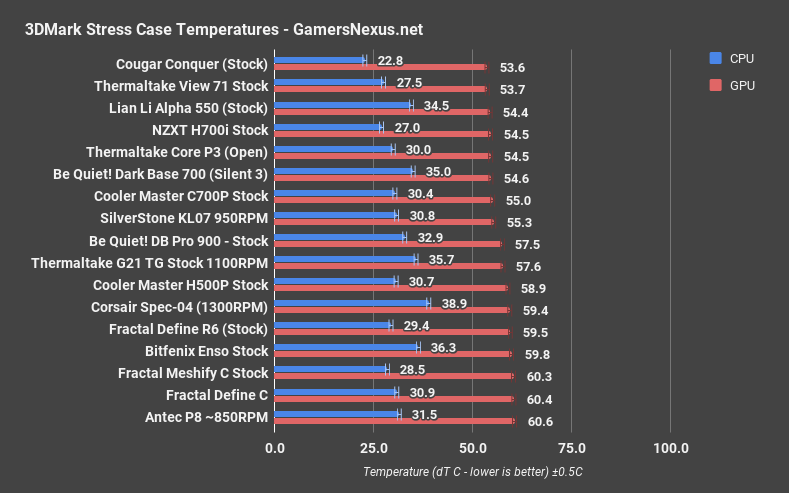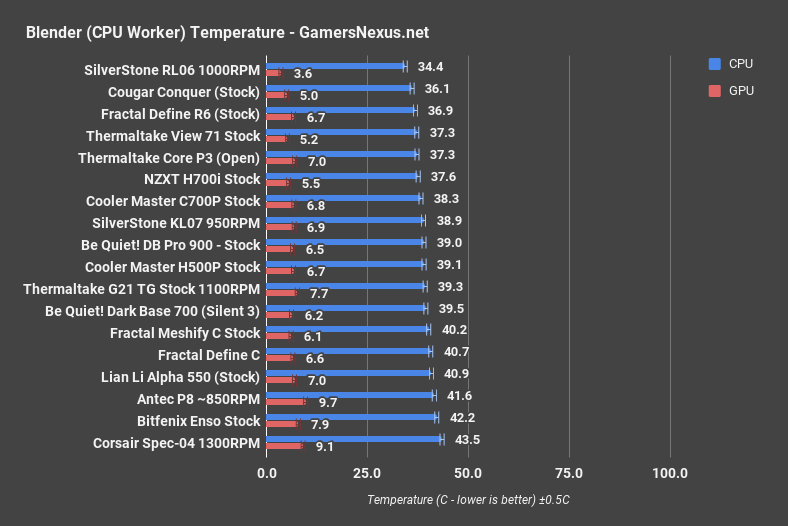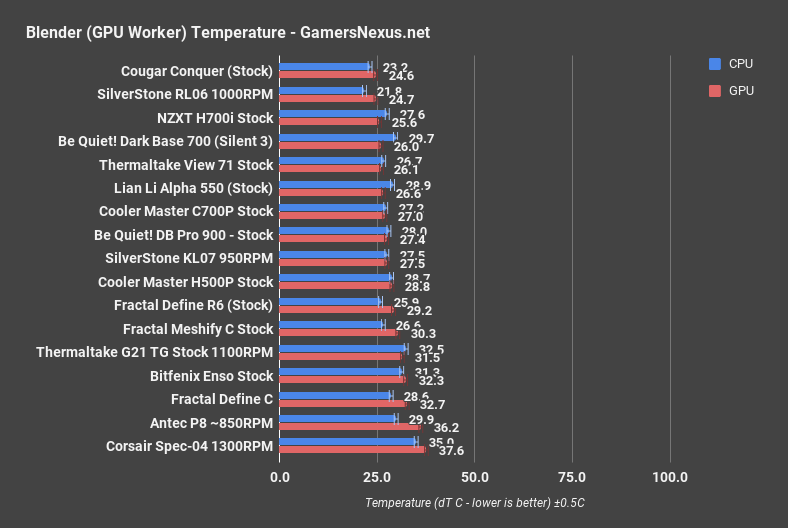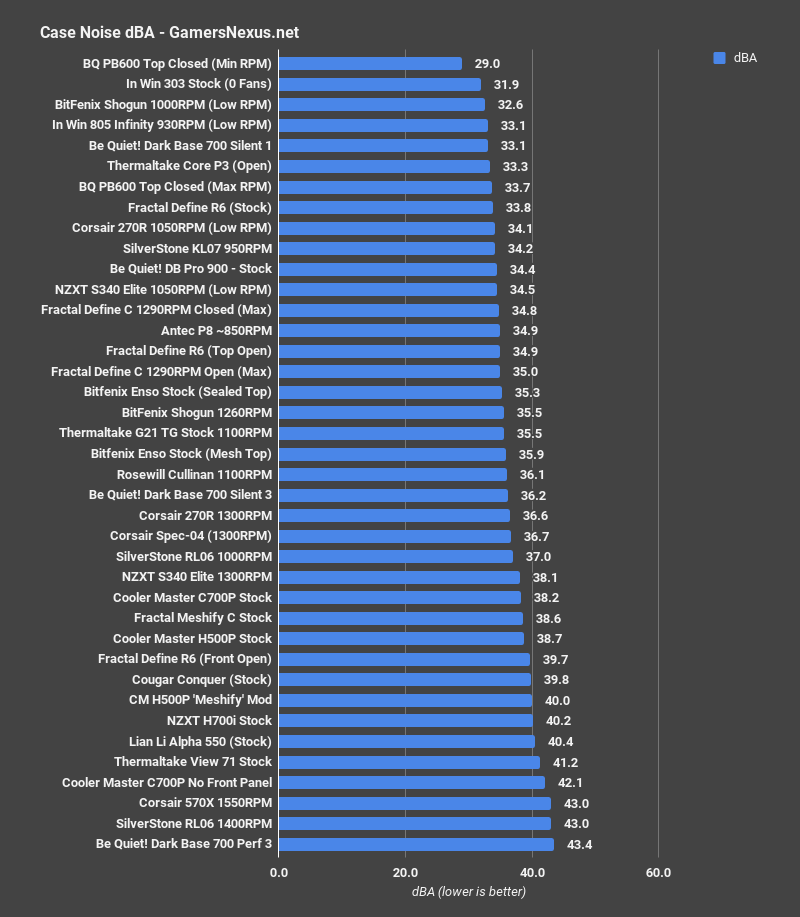Lian Li Alpha 550X Case Review: Thermals, Noise, Build Quality, & Cable Management
Posted on
Lian Li is known more for unusual cases -- enclosures shaped like yachts, trains, or desks -- rather than more practical everyday midtowers, but the new Alpha 550 ($190-$220) and Alpha 330 ($100) cases may change that. This is our second attempt at reviewing the Alpha: the first review sample came with no side panel and a box of free diamonds, courtesy of the shipping service. We’re reviewing the second one today, a shiny new Alpha 550X, and will be looking at thermals, noise, and build quality, with comparisons to the Alpha 330.
Looks
The Alpha 550 is all glass externally, with thin strips of mesh at the edges reminiscent of the Bitfenix Shogun. The borders of both side panels are blacked out, but the panel behind the motherboard has a wider border that obscures the PSU shroud, an interesting compromise that doesn’t leave cables visible as some other double-glass-panelled cases do. The filters are reinforced with a diamond lattice pattern starkly backlit by the LED fans. There’s minimal branding, just a subtle etching at the bottom of the front panel and a couple of logos embossed on the interior.
It might not be obvious from some advertisements, but RGB LEDs feature heavily in the the 550 (but not the 330). The three front fans are ringed by sixteen LEDs apiece and their blades are close enough together that the lighting is extremely smooth and even, and all three 120mm front slots are populated, avoiding the asymmetrical look of the stock View 71. There’s also an LED strip below the front I/O, synced with the fans by the controller. By default, it’s set to a hideously garish demo mode that cycles between every available color scheme and animation pattern, but this can be turned off easily. The controller itself was a weak point of the case, which we’ll discuss more later in the article. The fans are the strongest point, as they’re encased in metal (costly) and have heavily customizable RGB LEDs.
Lian Li Alpha 550 Case Specs
Case Type | Mid Chassis |
Dimensions (W x H x D) | 230mm x 546mm x 450mm |
Color | White or Black |
Front Bezel Material | Tempered Glass |
Side Panel | Tempered Glass |
Body Material | SECC |
Net Weight | 13.2kg |
Drive Support | 5.25” x 0 |
M/B Support | ATX |
System Fan | Front: 3 x 120mm (included) or 3 x 140mm Top: 3 x 120mm or 3 x 140mm Bottom: 3 x 120mm Rear: 1 x 120mm (included) |
I/O Ports | USB 3.0 x 2 |
VGA Card Support | 400mm (length), 170mm (depth) |
CPU Cooling Support | 170mm (height) |
Radiator Support | 360mm x 120mm / 420mm x 140mm |
Build
Building in the Alpha 550 was a breeze. There was a brief moment when it seemed that the HDD cage was going to block the PSU from entering the case as it did in the Enso, but removing one thumbscrew allows the whole hard drive cage to slide out smoothly. The front and top panels are held firmly enough to avoid danger and there are nice wide filters clipped in underneath. The filter below the case slides out from the side, which works a lot better than the usual method of sliding it in under the front panel. The side panels have nothing to catch them once the screws are removed, which should be standard by now in tempered glass cases.
There’s a cable management shield behind the motherboard held in with heavy-duty hinges that helps to squash the nest of RGB fan cables into place (it really is a nest). Many cases allow space above the motherboard for fan and radiator mounting, but often it’s separated from the rest of the case--in the 550, there are just a couple inches of clearance above the motherboard, allowing for easy CPU power and other cable routing, which is impressive given that it shares tooling with the shorter Alpha 330. There are cable cutouts in the motherboard tray, but they’re at the very front of the case and are mostly useful for the fan cables. For everything else, there’s an excellent cable management bar with cutouts for velcro ties. It doesn’t look like any cables would be able to fit beneath it, but there are cleverly placed cutouts that allow 24 pin ATX cables to pass through easily.
Ventilation doesn’t look amazing, but it’s a tempered glass case. There are small strips of mesh to allow air in (more than the Enso, at least) and the PSU shroud is full of air holes. Lian Li claims that this provides “great airflow,” because that’s what everyone always claims, but “great” is subjective. In addition to the three 120mm RGB front fans, there’s one less-fancy 120mm exhaust fan included, and there’s space for more at the top of the case. The mounts at the front and top are on removable frames, so there’s no need to maneuver a screwdriver around inside the case to get radiators secured--and the removable frames are the same on the top and front of the case, in the event that a quick swap is necessary.
Front I/O includes two standard USB 3.0 connectors and one USB C, hidden behind a plastic door that flips down. There’s no reset switch, power LED, or HDD LED, so there’s only a single front panel connector. The door is a little flimsy compared to the rest of the case and must be pushed in a specific spot to open, but it’s still a neat idea that allows the case surface to remain sleek. Opening the front panel door every time the system is turned on or being forced to leave it open permanently to keep a USB headset plugged in might get old.
Fan Hub/LED Controller
Firstly, it’s important to note that the three RGB fans, their controller, the RGB strip, and in fact the whole upper inch of the case is exclusive to the 550, which is reflected in its price. The lower-end 330 lacks a glass top panel and the little I/O door.
The LED fans bundle four RGB and three PWM wires into a single plug, which is convenient in terms of cable management but doesn’t allow the fans to be connected to typical fan or RGB headers. Instead, they must be connected to Lian Li’s controller. This controller seems like it’s replaced an older design: there’s only one screw hole (there should be two) drilled in the case for it, and there’s an empty spot on the front I/O with a diagram of a button labelled “RGB” but no actual button. There is no mechanical control, and there’s also no way to control via the motherboard with CAM or other software. Instead, LED color, pattern, speed, and brightness are all adjusted with a remote control. On the bright side, there is a lot of customization available, and there are some wild baked-in animations. The fans and LED strip sync well with each other for the most part (our bottom fan was rotated one turn out of alignment) and the use of a remote does allow for more detailed controls than the usual “press button to change color.”
Fan speed is controlled via a PWM header attached to the motherboard, so the main benefit of bundling RGB/fan power together and connecting the fans to the hub is to reduce cable clutter. The exhaust fan has a normal 3-pin fan header and a molex plug, so even though there are empty slots on the hub, it must be plugged in elsewhere.
To summarize: Lian Li’s fans must be connected to Lian Li’s controller, and Lian Li’s controller must be be adjusted with Lian Li’s remote. The BORA 120mm RGB fans are very well made and currently go for $40 on Amazon (with a controller). It’s understandable that Lian Li would want their fans to be connected to their RGB controller to make sure they can take full advantage of the individually addressable LEDs with the variety of animations that they did, but it’s a shame the fan connectors are bundled in as well, when they could just as easily be separate standard 3-pin connectors. Plus, we’ll probably lose the remote.
Case Testing Methodology
We tested using our new Skylake case test bench, detailed in the table below. This particular configuration is brand new with the launch of the 570X & 270R. Results on this test platform cannot be compared to previous case benchmark results, as the platform has completely changed.
Conducting thermal tests requires careful measurement of temperatures in the surrounding environment. We control for ambient by constantly measuring temperatures with thermocouples and laser readers. We then produce charts using a Delta T(emperature) over Ambient value. This value subtracts the thermo-logged ambient value from the measured diode temperatures, producing a delta report of thermals. AIDA64 is used for logging thermals of silicon components, including the GPU diode.
All case fans are manually configured to their maximum throughput using BIOS, then we configure to an RPM closer to 1050 for a universal "quiet" testing. If a fan controller is present, we opt-in and test on multiple settings. This forces testing of case fan performance in addition to the case's air channeling and airstream design. This also ensures minimal variance when testing, as automatically controlled fan speeds can reduce reliability of benchmarking. The CPU fan is set to 1100RPM (constant) for consistency, and the CPU is overclocked to 4.4GHz with a vCore of 1.272V (constant). C-States and power saving states are disabled.
| Component | Courtesy Of | Price | |
| Video Card | MSI GTX 1080 Gaming X (OC Mode) | MSI | $640 |
| CPU | Intel i7-6700K @ 4.4GHz | GamersNexus | $300 |
| CPU Cooler | MSI Core Frozr L | MSI | TBD |
| Motherboard | MSI Z170A Gaming M7 | MSI | $180 |
| Memory | Corsair Vengeance LED 32GB 3200MHz | Corsair | $200 |
| SSD | Samsung 850 EVO 120GB | Samsung | N/A |
| PSU | Corsair RM650x | Corsair | $100 |
| Case | This is what we're testing! | - | - |
The video card is configured to run at 55% fan speed at all times.
Prior to load testing, we collect idle temperature results for ten minutes to determine the unloaded cooling performance of a case's fans and air channels. Thermal benchmarking is conducted for 1400 seconds (23 minutes), a period we've determined sufficient for achieving equilibrium. The over-time data is aggregated and will occasionally be compiled into charts, if interesting or relevant. The equilibrium performance is averaged to create the below charts.
Load testing is conducted using Prime95 LFFTs and Kombustor “FurMark” stress testing simultaneously. Testing is completely automated using in-house scripting, and executes with perfect accuracy on every run.
We recently validated our test methodology using a thermal chamber, finding our approach to be nearly perfectly accurate. Learn more here.
Thermals & Noise
The Alpha 550 comes with three intake fans and one exhaust, so we didn’t bother testing with extra fans or serious reconfiguration. Instead, we did the usual vertical GPU test (spoiler: it’s bad for air cooling) and tested without the front panel to see how much it obstructs airflow.
CPU Torture
Under the full system torture workload, CPU temperature averaged 60.4 degrees Celsius over ambient, and 56.2C delta T over ambient with the GPU mounted vertically. That’s typical of the cases we’ve tested--but the GPU typically reports a higher temperature in vertical orientation, given that it’s pushed against a glass insulator. There’s less radiative heat coming off the backplate of the GPU, which will favor CPU temperatures marginally. With the front panel removed and the filter left in place, CPU dT plummeted to 46.7C. That degree of airflow limitation is to be expected in a case with so much glass, but also shows what’s being given up in favor of a front glass panel. The difference, of course, comes down to whether the case is marketed as high airflow. This case doesn’t have marketing materials that lay claim to high airflow, unlike the Enso and H500P, but it could still use some help in that department.
The crazy thing, though, is the 10+ degree swing by removing the front panel. We’re suffocating, here; the case doesn’t have to be fully redesigned. It can still have glass everywhere, it can still have the Lian Li look -- just make the side ventilation a little bit wider, give some more breathing room at the bottom and/or top, and it’ll make up a lot of that room.
With the front panel on, the 550 is around the Bitfenix Shogun and the stock In Win 303 in CPU cooling. It’s definitely warm, but Lian Li has managed to make this a functional case rather than exclusively a showpiece. The View 71’s significantly lower CPU dT of 54.7 degrees is the strongest direct competition to the 550 , thanks to Thermaltake’s offset glass panels that allow air to circulate underneath. The Alpha 550 runs about the same as the Dark Base 700 with its Silent 3 setting, and 4 degrees warmer than the airflow-marketed H500P.
GPU Torture
As for GPU temperature, that reached 52.3C over ambient in torture testing, but overheated (as usual) when vertically oriented, with an average about 10C higher for 62C. This isn’t an inherent problem with the orientation, it’s a problem with typical case dimensions: most cases that offer a vertical GPU mount push it as close to the side panel as possible to allow for CPU cooler and PCI card clearance, which severely limits the air intake of the GPU. This becomes more of an issue with air-cooled cards, as it’s much easier for cool air to enter the card in a horizontal orientation, thanks to the 550’s intake fans pushing air along the top of the PSU shroud, as well as the perforations in the PSU shroud. Another issue arises in card height for some cases, where the plus-sized PCBs sometimes do not fit in a vertical mount while using a CPU tower cooler. Removing the front panel only lowered GPU dT two degrees to 50.1C, meaning that the stock configuration is already close to the best-case scenario, and Boost functionality begins interfering, anyway.
Stock GPU temperature was impressively cool relative to other cases, given the restrictive front panel and the warm CPU temps. It’s on par with the stock NZXT H700i and the Thermaltake Core P3, both cases that performed well in our testing. Even the stock View 71 is less than one degree cooler.
3DMark
60 loops of 3DMark’s Firestrike Extreme stress test warmed the GPU to 54.4C dT, another competitively cool score. The Alpha 550 does surprisingly well on GPU thermals, and is a factor of how the fans are aligned with the face of the card. The View 71 is again less than one degree cooler, and the H700i and Core P3 are again roughly equal. The three 120mm intake fans do a great job of pushing air along the bottom of the case to the GPU, which is top priority anyway--GPUs are much more susceptible to clock drops based on thermals than CPUs.
Blender
Blender rendering on the CPU caused CPU dT to average 40.9C, on the same end of the chart as sealed-off cases like the Antec P8 and cases with half as many fans, like Fractal’s Define C and Meshify C. There’s a fan pushing air into the CPU cooler and another fan pulling air out, so this is about the best the Alpha 550 can do for CPU cooling without using top intake or a radiator. Part of this is the distance of the cooler from the front panel, as the air loses most of its pressure by the time it gets that far into the case.
GPU rendering brought GPU dT to 26.6C, still slightly warmer than the View 71, but not by much. Considering that the worst result (the Corsair Spec-04) scored 11 degrees higher, the 550 is definitely pulling its weight in the GPU cooling department.
Noise
It’s a loud case, but that shouldn’t be a surprise. There are a lot of fans, they’re 120mm, and they spin up to 1900RPM if the spec sheet is to be believed (the fans don’t report their speed to AIDA64 since they aren’t connected to the motherboard). 40.4 dBA is audibly equivalent to the H700i and the View 71, both of which are near the top of the chart for noise levels, but the fans could be turned down for daily use. Just watch out for thermals in heavier workloads.
Conclusion
The Alpha 550 is a good-looking case with acceptable performance that’s let down somewhat by its bundled accessories, much like the H700i. However, unlike the H700i, the 550 ships alongside a cheaper case that strips these features: the Alpha 330. When we reported on Lian Li in our Best Cases roundup at Computex, it was the 330 that seemed most promising out of their lineup. The primary “downgrades” are the lack of Lian Li’s fancy Bora fans and no tempered glass top panel, but the mesh filter that replaces it probably has better airflow anyway. We don’t have an Alpha 330, so it’s worth examining the product listing carefully and checking reviews of the 330 for any differences we may have missed, but it seems to be a much better value at $100 (currently on sale) versus roughly double that for the 550X.
Performance-wise, the Alpha 550 does well for what it is: a case with four visually impressive glass panels. It doesn’t beat out the four-glass-panelled Thermaltake View 71 (non-RGB SKU) despite having more stock fans, and the View 71 is currently available for $150, which makes it an easy recommendation over the 550. Overall, the View 71 beats the 550, but the Alpha 330 is a good value compared to both. The Rosewill Cullinan is also worth consideration, as it includes a full complement of fans (the 330 only has one) in addition to three glass panels at a slightly higher price, usually around $110.
Editorial, Testing: Patrick Lathan
Test Lead, Host: Steve Burke
Video: Andrew Coleman
